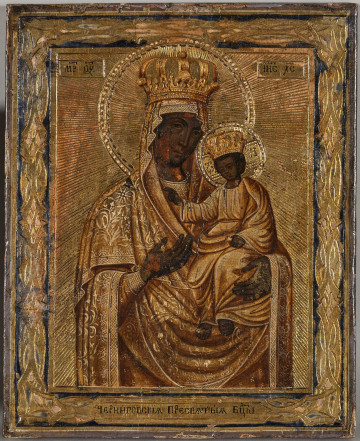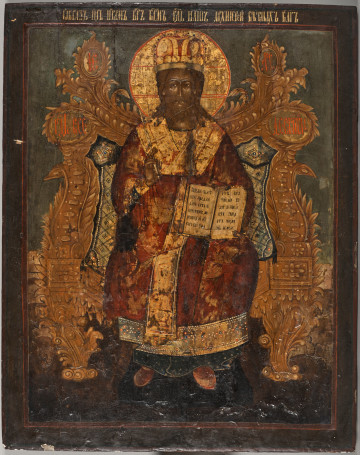
The Mother of God of Hodigitria
19th (?) century
Castle Museum in Łańcut
Part of the collection: Ikony
Crucifixion, silhouette icon. Crosses cast in brass and decorated with enamel were objects of religious worship widespread in Russia. The earliest products of this type came from Byzantium; over time, they were replaced by local ones. From the end of the 17th c. until the 20th c., the production of cast crosses and icons concentrated in the hands of the Old Ritualists - the followers of the old Rus church tradition, who did not accept the liturgical reform initiated by Patriarch Nikon in Moscow Orthodoxy in the middle of the 17th c. The Old Ritualists accepted only the eight-pointed cross with three crossbeams, typical in the Rus tradition (see S.12789MŁ – 12795MŁ; S.12869MŁ; S.12871MŁ; S.12873MŁ – 12876MŁ). Persecuted in Russia, the Old Believers formed separate communities that developed their own rules for creating images and produced objects of worship. These objects were also gladly used by the adherents of the official Orthodox doctrine. Different views on the proper ways of depicting and describing images placed on crosses emerged between specific communities of the Old Believers. In contrast to the Priestless communities, who rejected the ministry of priests since the liturgical reform, the Priested communities were more open to the influence of the official Church. From the middle of the 18th c., one of them has developed in central Russia, in the Guslitsa region near Moscow. In the 19th c., the Guslitsa region became one of the most important centres of casting, producing crosses, single-panel and folding icons, etc. A characteristic feature of the products from Guslitsa and those modelled on them were the winged heads of seraphim, also known as cherubs, mounted on pins (see S.12872MŁ; S.12875-12876MŁ). Guslitsa castings and their imitations began using imbrication in the backgrounds, as can be seen on the displayed cross.
Dimensions
height: 15.5 cm, width: 9.5 cm
Object type
Icons
Technique
cast, enamelling
Material
brass, varnish enamel
Origin / acquisition method
decyzja administracyjna
Creation time / dating
Creation / finding place
Owner
Castle Museum in Łańcut
Identification number
Location / status

19th (?) century
Castle Museum in Łańcut

1800 — 1850
Castle Museum in Łańcut

1800 — 1899
Castle Museum in Łańcut
DISCOVER this TOPIC
National Museum in Lublin
DISCOVER this PATH
Educational path